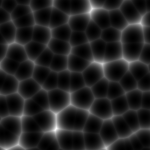Worley Noise
Worley noise (also called Voronoi noise) is a noise function first proposed by Steven Worley in 1996. Worley noise is an extension of the Voronoi diagram that, for each coordinate, returns a real value corresponding to the distance of the $n$th nearest site.
Creating Worley noise (Processing)
Processing is a Java-based IDE that requires minimal setup to get images onto the screen. Processing is free to download at processing.org.
Setup
- worley.pde
void setup(){ size(500,500); background(100); } void draw(){ loadPixels(); updatePixels(); }
The setup() function is called once. In it, the canvas size is set to 500 by 500 pixels on the $x$ and $y$ axes, respectively. The background() function sets the background colour of the canvas. In this case, the background colour has been set to $(100,100,100)$, just grey.
The draw() function has been created for later. It is called repeatedly, and for now, it loadPixels() to get data from the canvas into the pixels[] array, and it updatePixels() to update the canvas with data from the pixels[] array. The result of this code should be a static grey canvas.
Creating a grid (optional)
A naive approach to Worley noise would be to iterate over each site for each canvas pixel. Each canvas pixel must be processed; that is inevitable. However, we can use optimizations to minimize the number of sites we must process per-pixel.
The optimization involves a grid-based approach where each grid cell has a fixed number of sites. In the code below, a 6×6 grid is used to plot 36 sites (1 site/cell).
- worley.pde
PVector[] sites; void setup(){ size(500,500); background(100); sites = new PVector[36]; // plot loops here }
Plotting points
Calculating distance
